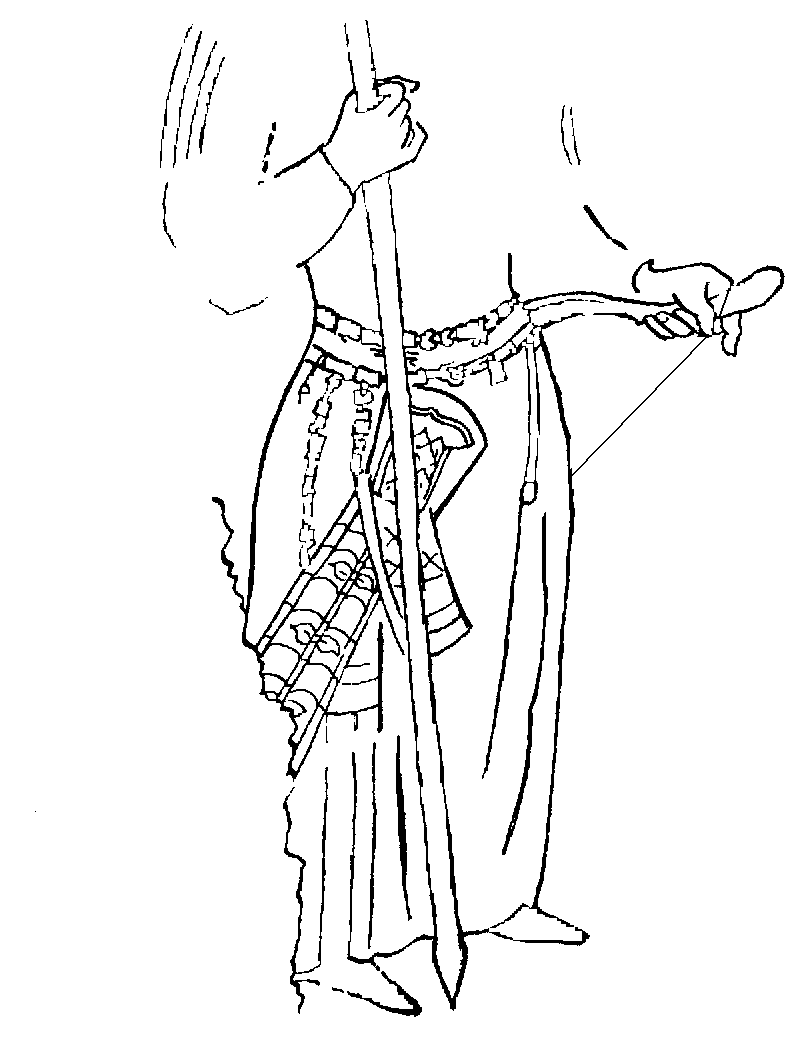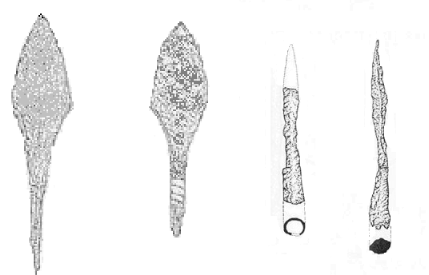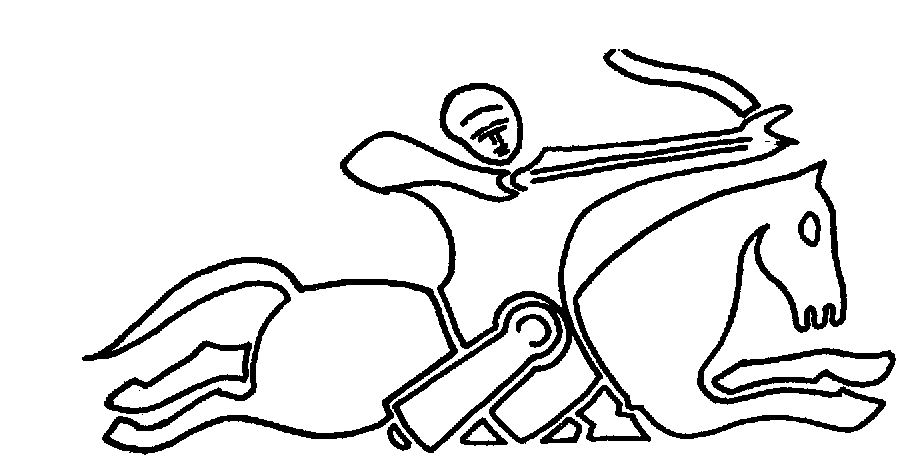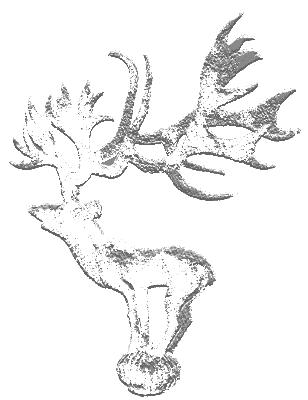A BRIEF HISTORICAL OVERVIEW OF HUNGARIAN ARCHERY,
PART I
by Chris Szabó
[Christopher Andrew Szabó, a second-generation Hungarian
born in London, has had a lifelong fascination with Old Magyar Archery. Since illness put
paid to a succesful journalism career, Chris has written numerous articles on Hungarian
history and military history. The present articles are a very basic introduction to the
broad theme of Old Magyar archery.]
THE LEGEND OF THE MIRACULOUS STAG
INTRODUCTORY NOTES
Most people think Hungary is a regular Central European country. This
is not surprising as the Hungarians have been in their present homeland since the 10th
century, and a thousand years is a long time by any reckoning.
However, should one do no more than scratch the surface, there are a
lot of surprises, including the fact that the ancestors of these Europeans come from Asia.
There are very many strands that still connect the Hungarians to various parts of Asia,
such as striking similarities between some aspects of Hungarian folklore and that of
Siberia; some forms of cooking being almost the same in Hungary and parts of Northern
China; linguistic connections with Turkic and Finno-Ugrian peoples and many more.
The most striking similarities, however, are to be found in the
lifestyle of the early Magyars (the name by which Hungarians call themselves), military
equipment, military tactics and strategy, political thinking and dress. These show
striking similarities with other steppe peoples, and much weaponry and horse-accoutrements
have counterparts as far away as Mongolia, Northern China, and Transoxania, as well as
Persia. To name a few of these weaponry items: The curved sabre; the Magyar
"framed" saddle; metal stirrups, clothing of Central Asian cut; and the mainstay
of their military prowess, the recurved composite bow. (1. Nicolle, D. The Age of
Charlemagne. Osprey, London, Hong Kong. 1984. ISBN 0-85045-042-x and 2. Lászlo Gy. Számadás
Nepünkrol. (‘An Accounting of Our People’) Ifjusági Lap-és Könyvkiadó
Vállalat 1986. ISBN 963-422-780-5).
The Old Magyar bow was made of five materials. Softwood; a glue made
from fish air-bladders, called halenyv (fish-glue); sinew; horn and bone. The core
was shaped to accommodate the grip, two flexible "karok" or
"arms", and two "szarvak" or "horns" at the ends of
the bow. Some research indicates that the wood was first bent under steam opposite to the
direction in which it would eventually be drawn.
The back of the bow was strengthened by sinew. This was either done by
layering the sinew to the softwood core or by gluing in bundles. (Kornél Bakay IN: 3. Régészeti
Barangolások Magyarországon. (‘Archaeological Wanderings in Hungary’).
ISBN 963 243 109 X). There were also some sinews twisted into thongs and tied around the
bending points of the bow, where the basic components joined. There is some argument as to
whether these were visible or not, as well as whether there were in fact five different
pieces of wood, or only one, that is the wood core itself.
The sinew gave the wood bow a great amount of springiness, allowing it
to be drawn further than a self-bow, and also more easily. To balance this, on the belly
side, horn was added, most of which was probably from the ancestors of the Hungarian
longhorn "grey" cattle.(Interestingly, these animals look almost identical to
the famous Indian Brahmin cow.)
The horn added stiffness to the bow, and further, prevented the bow,
once it had been fired, from going too far forward, causing "bowstring slap" and
thus wasting kinetic energy. This is why Old and Medieval Magyar archers are never shown
wearing any arm or hand-protection.
Finally, in the Magyar bow, six pieces of bone were added. These were
normally 2 to 4 millimetres thick and up to 30 centimetres (circa. one foot) long. They
were glued to the wood core at right angles to the sinew and horn layers. Two were used to
cover the so-called "horn" of the bow, two for the grip, and two for the other
"horn" or end of the bow. The outer-side of these bone pieces was normally
smooth, while the side to be glued to the wood is known to have been scratched rough, to
help it stick.
It was these pieces of bone which would give archaeologists the clue as
to how the Old Magyar bow was constructed. The bow would eventually be covered by a thin
material, which presumably varied with time and place. It could be snakeskin, thin leather
or bark.

One of the first reconstructions of a Magyar bow,
showing drawn, strung and unstrung positions.
Copyright Chris Szabó, after Professor Gyula László.
The final product would most probably look like this: The grip of wood
overlaid by bone, limbs of possibly coloured leather or bark, and uncovered, visible ends
("horns") of bone. Research continues into materials used for bowstrings, but
there is an ongoing oral tradition indicating gut as the main component.
The making of such a bow took a long time – even years – due
to the need for "curing" the various materials. The Old Magyars valued their
bows, which were important to them not only in warfare, but in supplementing their diet by
hunting. This can be seen by how much care was taken of the bow. When
unstrung, it was
placed in a soft leather container slung from the left side of the archer on a
belt, and
when strung, it was carried in a hard-leather and metal bowcase also on the left
side. (4.
Magyar Internet Könyvtár (‘Hungarian Internet Library’) quoted on Letizia
Íjász Klubb (‘Letizia Archery Club’) at: alt.date.hu/letiziasc
The hunters or soldiers would presumably wear the soft C-shaped bowcase
when they were not expecting to use the bow immediately, while the half-bowlength hard
leather case would no doubt be worn when they expected battle, or flushed game.
Two belts were worn, one held the sabre (on the left side), a decorated
pouch and possibly other things, while the other held the bowcase on the left and a quiver
on the opposite side. (5. Padányi V. Dentumagyaria, Editorial Transsylvania,
Beunos Aires, 196? and 5.Wang Bian quoted in www.silkroad.com, 03/02/1998.)
The Magyars also looked after their arrows, putting them in a special
quiver, (tegez) which could be closed against the weather. This was also worn on
the right side, with the arrowheads pointing upwards.

Drawing based on a piece of a wall painting in Eastern Turkestan of a
distinguished Uygur archer. Both his bowcase and quiver are suspended from his belt, as
among the Magyars and other steppe people.
Copyright Chris Szabó, after Professor Gyula László.
Judging from their draw, depicted on old Magyar and Medieval art as to
the right shoulder for a right-handed archer, arrows would generally be around 75
centimetes long (or 30 inches). Of course, this can only be an approximation, as the
arrow-lengths would vary from archer to archer. The material of the arrows is believed to
have been wood or reed. Fragments show linden, hazel and birchwood used ( Dr Gábor
Szollosy quoted in 5. M.I.K.) and although there is no concrete proof, oral traditions
speak of reed arrows, possibly strengthened by wood or bone. The fletching would have been
quite long, like similar Asian bows, and there is a tradition stating that the Huns used
eagle-feathers for fletching.
Dr Szollosy, in the same article, referring to the work of the noted
researcher Károly Cs. Sebestyén, describes the Magyar arrowheads as having a stem, and
generally the leaf-shaped arrowheads were quite large. A typical such Magyar arrowhead,
including the stem, would be 55-110 mms long (2.1 to 4.29 inches) and 20-40 mms (0,78 to
1.56 inches) wide. An arrowhead weighed 20-30 grammes, or between 0,72 and 1,08 ounces.

These arrowheads show iron Magyar arrowheads in use in the 10th
Century.
The two at left are more common, while the two at right are armour-piercing.
Copyright Bálint Csikós
This composite bow was not the main Magyar weapon for nothing. A record
from Poland indicates a cast of 300 metres (Padanyi) and researchers suggest an average
draw-weight of around 70 pounds.
The Legend of the Wondrous Stag is, along with the Legend of the Turul
Bird, one of the two oldest legends of the Hungarian nation. The bow figures already in
the legend (which is the story of a hunt) and at the same time can be seen as an oral
history of the Magyar people as well as other semi-nomadic peoples of the steppe. Seen in
this light, the legend tells of their origins as well as the long wanderings of the
peoples, expressed as a story. The word "csoda" in Hungarian cannot be
translated simply in one word, so the various terms "wondrous,"
"miraculous" and even "magical" will be used.
THE LEGEND OF THE MIRACULOUS STAG
The oldest written version of this widespread Eurasian legend in
Hungarian comes from the "Gesta Hunnorum et Hungarorum" or "Deeds of the
Huns and Hungarians" of Master Simon de Keza, (Kézai in Hungarian) who wrote his
chronicle around 1282. A.D. Some parts relevant to the present subject are quoted below:
BOOK ONE
THE HISTORIES OF THE HUNS FROM THEIR BEGINNINGS TO THE DEATH OF ATTILA
AND THE BREAK-UP OF THEIR EMPIRE.
CHAPTER I.
On the Origins of the Huns and Magyars and their Ancient Homelands.
Kézai first argues against the common western conception that the
Magyars and Huns were descendants of demons, and goes on to link the father of the
eponymous ancestors of the Magyars and Huns in the Hungarian oral traditions, Menroth or
Nemrot, with the Biblical Nimrod.
2 § Concerning the Tower of Babel.
As every living thing, excepting Noah and his three sons, had perished by means of
the blows of the Flood; finally from Shem, Ham and Japheth seventy-two families descended:
from Shem, twenty-two, from Ham, thirty-three and from Japheth seventeen. And those
families, as Josephus says, spoke the Jewish tongue. In the two-hundred and first year
after the Flood came Menroth the giant, son of Thana, who with all his brethren,
considering the past danger began to build a tower, so that if the Flood were to perhaps
come again, they might, by fleeing into the tower, avoid the angry judgement. (Of
God..translator). (…)
3. §. Nemrot moves to Persia. His sons, Hunor and Mogor are the
ancient ancestors (fathers) of the Huns and Magyars.
Avoiding therefore the events, which gave colour to the beginning of our subject,
we must return to Menroth the giant, who after the beginning of the Confusion of Tongues
went to the land of Evilath, which in these days is called the territory of Persia, and
there, from his wife Eneth he begat two sons, as it should be known, Hunor and Mogor, from
whom the Huns or Magyars are descended. (…) And as Hunor and Mogor were firstborn
sons, they, separating from their father, went to live in separate tents. It happened, as
they went hunting on one occasion, they came suddenly upon a deer-hind, which, as it ran
before them, they chased into the marshes of the Meotis. And as it disappeared quite
completely before their eyes in that place, they sought it long, but by no means were they
able to find it. Finally, they traversed the mentioned marshes, they viewed that land to
be useful for animal husbandry.

Drawing based on the metal belt-endpiece found in the grave of an Avar
horseman at Klárafalva. Circa 8th Century A.D.
Copyright Bálint Csikós
4. §. Hunor and Mogor move amongst the marshes of the Meotis.
Returning to their father and taking their leave of him, they took all their
possessions and went to live among the marshes of the Meotis.The territory of Meotis,
meanwhile, shares a border with the homeland of Persia (…) And after they had stayed
amongst those marshes for a longer time, it happened that they began to grow into a very
great nation and the place was no longer able to hold them or feed them.
5 . §. Hunor and Mogor move to Scythia. Description of Scythia
Therefore from there having sent spies to Scythia, and after having scouted out
the country of Scythia, they proceeding to that homeland marched, with their children and
animals, that they might live there.
(Some pronunciation and translation notes, in order to avoid
confusion: The names Nemróth, Hunor and Mogor are pronounced roughly as follows Nemróth:
"Nem-wrought" to ryhme with "wrought-iron". Hunor: Hoon-or as indeed
the Hungarian name "hún" is pronounced closer to "hoon" and not to
ryhme with "Nun". Mogor-Magor. Is pronounced rather like "Moh-gor or
Mah-gor" and to ryhme rather with "Far" than with "May" or
"say." The names with "th" are an old-fashioned spelling of the simple
"t" sound. Hungarian has no sounds corresponding to the English "th"
as in "thought" or "this.")
General Notes:
It is clear that in the Kézai Chronicle, the ancestors of the Magyars
are shown as being semi- or fully nomadic, as is clear in his reference to
"tents", as well as to the relatively easy movement of Hunor and Magor from
their father's home to the one in the Meotis, and from there, the relatively easy movement
to Scythia. Kézai knew very well that he was contradicting the western chroniclers of his
time and those who had gone before, some of whom he named. He was clearly proud of his
eastern heritage, which he appears to have been in touch with.
Some clear pointers exist, besides the fact of his understanding of the
"transhumance-nomadism" of the Steppe peoples, much of which he could see
first-hand in the life of the Kun, or Kuman people, who had gone to live in Hungary. He
also appears to have had contact with oral traditions of the Magyars and other steppe
peoples, and further, to have access to Muslim learning, as his reference to "Menroth
the giant" show. Nowhere in Western Christendom, least of all in the Bible, is there
any reference to such a person, only to "Nimrod, a mighty hunter before the
Lord." The idea that Nimrod was a giant is more to be found in Muslim traditions and
writings. There were Muslims in Hungary at various times in the Middle Ages, both
Kwarezmians and Volga Bulgars.
In Medieval Hungary these groups of Muslims practiced their religion
freely (for example, the Kwarezmian royal bodyguards) and the people whose name in
Hungarian is ‘Böszörmeny’, or Volga Bulgars. Their descendants still live in
Tatarstan, on the Volga and Kama Rivers. Presumably Kézai got some of his information
from these people, many of whom were scholars, well-known as astronomers and astrologers.
It was also understood by the illustrators of the chronicles that Hunor
and Magor were using composite bows, as these were always accurately depicted, whether in
the hands of Magyars, Székely, Kumans or Mongols.
The above is a very brief version of the legend, which has more flowery
versions in Hungarian oral tradition, as well as having numerous versions in Asia Minor,
Iran and even in Finland, the Urals regions, and numerous mentions in western chronicles
(Widukind) and Byzantine ones (Procopius). There are also written versions in the east
like the chronicle of Mehmet Terdzsüman, the Tarih-I-Üngürüs, or History of the
Hungarians. It should be noted that most of these dwell more on the wonderful, miraculous
or even divine nature of the stag or hind. The Hungarian word "szarvas" means
"That which has horns" and therefore can be either a horned stag, or a horned
hind. The general gist of the story is that of two brothers chasing a wondrous, magical
hind or stag, with large antlers, shiny feet, possibly shiny coat, or even a blue coat in
one version (referring to its origins in the sky) and being led to a new homeland by the
magical animal, which, once its mission is accomplished, disappears.
Finally, the ancient Magyars believed themselves to be descended from
the Scythians as well as the Huns. This is found in all the early chronicles, and even in
Renaissance and 18th century sources, Hungarians proudly call themselves names like
"pure-blooded Scythians". The Hungarian language has its own word for these
people, "szittya" and many legends exist surrounding this aspect. The
important point to note is it was precisely the Scythian and Hun art that was
characterised by the widespread use of antlered animals, both stags and hinds. Of course,
from c.600 BC to c. 1500 AD, the composite bow was to be the weapon of choice of these
steppe people.

|